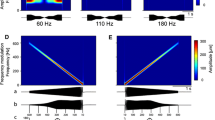Summary
The response characteristics of saccular nerve fibers in European grassfrogs (Rana temporaria) subjected to dorso-ventral, 10–200 Hz sinusoidal vibrations were studied.
Only 4 fibers out of a total of 129 did not respond to the vibrations.
70 fibers had an irregular spontaneous activity of 2–48 spikes/s. These fibers were very vibration-sensitive. The synchronization thresholds at 10–20 Hz varied from below 0.005 to 0.02 cm/s2.
In contrast to earlier results, all these fibers had low-pass characteristics (with respect to acceleration) and responded maximally at 10 and 20 Hz.
55 fibers had spontaneous activities from 0–2 spikes/s. These fibers were less sensitive than the fibers with higher spontaneous activity. The spike-rate thresholds varied from about 0.04 to above 1.28 cm/s2, giving a considerable range fractionation. Most of these fibers also had low-pass characteristics with respect to acceleration, but 8 fibers showed band-pass characteristics with maximal synchronizations and spike-rates occurring at 40–80 Hz.
At high acceleration levels, most spikes fell within 5–10 degrees of the stimulus cycle. The phase-locking of the saccular fibers is therefore very acute at low frequencies.
The phase angles preferred by the fibers at 10 Hz were bimodally distributed with the two peaks about 180° apart. This finding probably reflects the morphological observation that the saccular macula contains two oppositely oriented hair-cell populations. The results also indicate that the actual motion of the otolith relative to the macula is complex.
No behavioral role of a vibration receptor has been demonstrated in the grassfrog. A use in predator avoidance is likely, and it is possible that the sacculus is used for detection of water surface-waves. The vibration sense could therefore be of importance in the detection and localization of conspecifics in the breeding ponds.
Similar content being viewed by others
References
Ashcroft W, Hallpike CS (1934) Action potentials in the saccular nerve of the frog. J Physiol 81:23P-24P
Capranica RR, Rose GJ, Brenowitz EA (1985) Time resolution in the auditory systems of anurans. In: Michelsen A (ed) Time resolution in auditory systems. Springer, Berlin Heidelberg New York, pp 58–73
Elepfandt A (1982) Accuracy of taxis response to water waves in the clawed toad (Xenopus laevis Daudin) with intact or with lesioned lateral line system. J Comp Physiol 148:535–545
Fay RR (1978) Phase-locking in goldfish saccular nerve fibers accounts for frequency discrimination capacities. Nature 275:320–322
Fay RR (1985) Temporal processing by the auditory system of fishes. In: Michelsen A (ed) Time resolution in auditory systems. Springer, Berlin Heidelberg New York, pp 28–57
Goldberg JM, Brown P (1969) Response of binaural neurons of dog superior olivary complex to dichotic tonal stimuli: some physiological mechanisms of sound localization. J Neurophysiol 32:613–636
Görner P (1973) The importance of the lateral line system for the perception of surface waves in the clawed toad,Xenopus laevis Daudin. Experientia 29:295–296
Hudspeth AJ, Corey DP (1977) Sensitivity, polarity and conductance change in the response of vertebrate hair cells to controlled mechanical stimuli. Proc Natl Acad Sci USA 74:2407–2411
Kalmring K, Kühne R (1980) The coding of airborne-sound and vibration signals in bimodal ventral-cord neurons of the grasshopperTettigonia cantans. J Comp Physiol 139:267–275
Koyama H, Lewis ER, Leverenz EL, Baird R (1982) Acute seismic sensitivity in the bullfrog ear. Brain Res 250:168–172
Lewis ER (1983) Dual acoustical sensitivity in frogs. In: Klinke R, Hartmann R (eds) Hearing — Physiological bases and psychophysics. Springer, Berlin Heidelberg New York, pp 61–69
Lewis ER, Li CW (1975) Hair cell types and distributions in the otolithic and auditory organs of the bullfrog. Brain Res 83:35–50
Lewis ER, Narins PM (1985) Do frogs communicate with seismic signals? Science 227:187–189
Lewis ER, Baird RA, Leverenz EL, Koyama H (1982) Inner ear: dye injection reveals peripheral origins of specific sensitivities. Science 215:1641–1643
Mardia KV (1972) Statistics of directional data. Academic Press, New York
Markl H (1983) Vibrational communication. In: Huber F, Markl H (eds) Neuroethology and behavioural physiology. Springer, Berlin Heidelberg New York, pp 332–353
Matesz C (1979) Central projection of the VIIIth cranial nerve in the frog. Neuroscience 4:2061–2071
Michelsen A, Larsen ON (1978) Biophysics of the ensiferan ear. I. Tympanal vibrations in bushcrickets (Tettigoniidae) studied with laser vibrometry. J Comp Physiol 123:193–203
Moffat AJM, Capranica RR (1976) Auditory sensitivity of the saccule in the American toad (Bufo americanus). J Comp Physiol 105:1–8
Møller AR (1983) Auditory physiology. Academic Press, New York
Narins PM, Hillery CM (1983) Frequency coding in the inner ear of anuran amphibians. In: Klinke R, Hartmann R (eds) Hearing — Physiological bases and psychophysics. Springer, Berlin Heidelberg New York, pp 70–76
Narins PM, Lewis ER (1984) The vertebrate ear as an exquisite seismic sensor. J Acoust Soc Am 76:1384–1387
Ratnikova GI, Tsirulnikov EM (1980) Morphological and functional investigation of the saccular nerve in the frogRana temporaria. Zh Evol Biokhim Fiziol 16:60–65 (in Russian)
Walkowiak W (1980) The coding of auditory signals in the torus semicircularis of the fire-bellied toad and the grassfrog. Responses to simple stimuli and to conspecific calls. J Comp Physiol 138:131–148
Walkowiak W, Münz H (1985) The significance of water surface-waves in the communication of fire-bellied toads. Naturwissenschaften 72:49–51
Author information
Authors and Affiliations
Rights and permissions
About this article
Cite this article
Christensen-Dalsgaard, J., Buhl Jørgensen, M. The response characteristics of vibration-sensitive saccular fibers in the grassfrog,Rana temporaria . J. Comp. Physiol. 162, 633–638 (1988). https://doi.org/10.1007/BF01342638
Accepted:
Issue Date:
DOI: https://doi.org/10.1007/BF01342638




